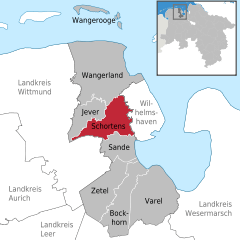Schortens
Schortens was an independent municipal and is now a town in the district of Friesland in Lower Saxony, Germany. [2]
Schortens | |
|---|---|
 Church of Saint Stephen | |
 Coat of arms | |
Location of Schortens within Friesland district   | |
 Schortens  Schortens | |
| Coordinates: 53°32′N 7°57′E | |
| Country | Germany |
| State | Lower Saxony |
| District | Friesland |
| Subdivisions | 12 districts |
| Government | |
| • Mayor | Gerhard Böhling (Ind.) |
| Area | |
| • Total | 68.67 km2 (26.51 sq mi) |
| Elevation | 6 m (20 ft) |
| Population (2018-12-31)[1] | |
| • Total | 20,329 |
| • Density | 300/km2 (770/sq mi) |
| Time zone | CET/CEST (UTC+1/+2) |
| Postal codes | 26419 |
| Dialling codes | 04421–23, 04461, 04468 |
| Vehicle registration | FRI |
| Website | www.schortens.de |
Division of the town
The town currently consists of the following districts: Schortens, Heidmühle, Grafschaft, Accum, Sillenstede, Schoost, Roffhausen, Middelsfähr, Addernhausen, Oestringfelde, Ostiem and Upjever. [3]
History
Graves discovered during excavations in the 1970s indicate the existence of an early human settlement in the area of Schortens already during the 5th century.[4]
In 1158 Schortens was first mentioned as "Scrotinh" in a document of Pope Adrian IV. Later the name changed to "Scrotinghe". In 1400 the place was called "Schortense".[5]
The St. Stephan Church in Schortens was built shortly after 1153 as a result of a victory of the Östringer against a superior army.[6]
In the Middle Ages, the monastery of Oestringfelde, which was also used as an asylum, was well known for its horse breeding.
During the second half of the 1900s, the naval base Wilhelmshaven contributed greatly to the development of the town. Many workers settled down in what would become central Schortens, a railway connection to Jever, established in 1871 also contributed to the development of the town. After the end of World War I, the production of warships ceased and unemployment escalated. From 1946, a steady stream of refugees have moved to Schortens, increasing the population greatly. The deployment of the opympia base in Roffhausen during World War II is also seen as an important stage in the development of the town.
In 1933 Schortens united with the towns of Cleverns and Sande to form the Greater Oestringen, this union was however dissolved during World War II.
In 1936 an air force base in Upjever was opened, which is still in use today.
Schortens received municipal rights on January 21, 2005. Since June 1, 2005, the city of Schortens is an independent municipality.
References
- Landesamt für Statistik Niedersachsen, LSN-Online Regionaldatenbank, Tabelle 12411: Fortschreibung des Bevölkerungsstandes, Stand 31. Dezember 2018.
- "Schortens - Entwicklung von der Gemeinde zur Stadt". Retrieved 10 October 2019.
- "Ortsteile von Schortens". Website Stadt Schortens. Retrieved 10 October 2019.
- Brune (Editor), Werner (1987). Wilhelmshavener Heimatlexikon, Dritter Band. Wilhelmshaven: Brune Druck und Verlagsgesellschaft. p. 74.CS1 maint: extra text: authors list (link)
- Brune (Editor), Werner (1987). Wilhelmshavener Heimatlexikon, Dritter Band. Wilhelmshaven: Brune Druck und Verlagsgesellschaft. p. 73.CS1 maint: extra text: authors list (link)
- "St.-Stephanus Kirche". Ev.-luth. Kirchengemeinde Schortens. Retrieved 11 October 2019.
Bibliography
- Werner Brune (Hrsg.): Wilhelmshavener Heimatlexikon. 3 Volumes. Brune Druck- und Verlagsgesellschaft, Wilhelmshaven 1986.
- Karl-Ernst Behre: Die Geschichte der Landschaft um den Jadebusen. Brune-Mettcker Druck- und Verlagsgesellschaft mbH, Wilhelmshaven 2012. ISBN 978-3-941929-02-9.